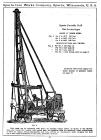1
Researching the McNarry family has been an interesting, elightening task. The following pages will introduce you in great detail to Leon McNarry. Leon was one who saved everything and his children, Ruth and Leon shared a moment that few of us experience in a lifetime. They opened their father's trunk after his passing and found his life all there for them to laugh and to cry over. Leon had many successes in his life but he also had tribulations. Follow us through the McNarry family storyline and become connected with this family as I have.K. Luhowy
Community Memories Co-ordinator
2
In 1989 as I began to type the McNarry family history, I planned about 75-100 pages. The story was to be based on the documents which Aunt Ettie had saved and her memories of life in England. However, that changes dramatically in July 1990. Marjorie and I opened my father's trunk to more carefully sort its contents. We discovered a number of interesting items such as celluloid collars, two framed prints of the Welsh countyside, a pair of heavy drapes, photographs, old newspapers and magazines. Neatly packaged at the bottom of the trunk were perhaps 2500 documents, among them were over 400 personal letters from 1906 to 1930. Most were from family members. That evening when reading many of them by a single, lighted kerosene lamp in our farm kitchen our emotions swung from pleasure to sadness. We laughed, and we wept, as we learned so much more of the lives of our family. An understanding of the love between my parents emerged. New information told us of the Saskatchewan homestead and its problems; we learned of Dad's family's plans to emigrate from Britain before the First World War. That information was new to both my brother Leon and me.The other 2000 or more documents such as mortgages, demands for payment of debts, bills of sale, postal receipts, doctor's bills, records of crops and their prices, along with details of daily events such as wind storms and crop failures told me so much about Dad and Mother's struggle to keep their farm viable. They lived under what must have been desperate circumstances, but through the letters one feels that though they had many financial difficulties, my parents were happy in their marriage. There has been great pleasure in having had the opportunity to know them more intimately.
Mother had been almost unknown to me because following her death, Dad had rarely spoke of her to us. When she died, he gathered together all of her possessions, including clothes, hats, handbag, shoes, even her handwork and stored them in her trunk. He could not bear to mention her, nor to see her personal belongings. Also stored away were the photographs of my grandmother and my father's Dunmow home, Chelmsford House. The trunk remained locked until 1964 when, following Dad's death, Leon and I opened it to discover Mother's possessions, including her ostrich-plumed broad-brimmed hat, georgette blouse, white pleated skirt, nightgowns, dresses and embroidery which had stopped mid-way to completion. We were emotionally moved by our discovery and began to understand why Dad had been so reluctant to talk about his wife. (Ruth McNarry-Meldrum 1995)
3
Robert McNarry and Lilla Clark were married on March 26th, 1883 in Parish of Great Dunmow in the County of Essex.5
Robert and Lilla were blessed with a family of eight children.Robert John Cable - February 19, 1884.
Gertrude Mary - April 26, 1885.
Leon - March 25, 1886.
William Hubert - May 15, 1887.
Ida Isabel - June 21, 1888.
Stillborn son - Unnamed
Oswald - September 5, 1889.
Harold - April 24, 1891
Blanche Ethel (Ettie) - November 8, 1893
6
The McNarry family resided in a few homes before settling at Clemsford House in Dunmow. (Ruth McNarry-Meldrum)8
According to an application for life insurance that Leon filled out in 1918, his father, Robert McNarry died of typhoid fever on his fourtieth birthday, November 10, 1896. Their eldest child Cable was twelve years of age while Ettie, the youngest had just celebrated her third birthday. With help from relatives, Lilla raised her sons and daughters. Before their father's death, the children attended Bigod's School that was established by the Countess of Warwick. Lilla was unable to send her children their once her husband died so the boys went into apprenticeships or they began to work at an early age. Cable and Leon helped their Mother financially as soon as they began working. (Ruth McNarry-Meldrum)10
In early 1905, Leon left England to settle in Canada. He began working in Guelph, Ontario but moved on to Manitoba where he began working for James Falloon at Foxwarren. He worked with the Falloon family for two or three years and then left for B.C. While in B.C. he worked for lumber companies and for the Canadian Pacific Railway. In November of 1908 he returned to England to assist in the move from Dunmow to Romford in Essex. After returning to Canada, Leon homesteaded near Foam Lake, Saskatchewan in 1909.12
There was a need for reliable water sources to provide for the rapidly growing population. Leon looked at this as an opportunity to become employed in the well-drilling business in 1910. Leon legally "abandoned" his Saskatchewan homestead to his brother Oss.During the first months Leon worked for a Mr. Dancer and worked mainly in the west and north areas of Brandon. He also did some work near Winnipeg, Manitoba. Leon was a quick learner and was employed with Dancer for a year when he accepted employment with Teddy Sheridan of Hamiota.
On many days drilling was hampered by stones, heavy clay and extreme heat. Leon often worked New Year's Day, Easter and most Sundays. He always had time off at Christmas.





